Industry Trends and Market Dynamics in Rice Packaging
The global market for rice packaging is undergoing significant transformation, driven by evolving consumer demands, advancements in material science, and increasing regulatory scrutiny. As a staple food for billions, rice requires robust and intelligent packaging solutions that ensure freshness, prevent contamination, extend shelf life, and enhance consumer convenience. Key trends shaping the industry include a strong emphasis on sustainability, the adoption of advanced barrier technologies, and the rise of smart packaging solutions.
Consumers are increasingly prioritizing environmentally friendly options, pushing manufacturers towards recyclable, biodegradable, and compostable materials. Simultaneously, the demand for convenience features such as easy-open zippers, re-sealable closures, and integrated handles continues to grow. From a technical standpoint, the focus is on optimizing multi-layer film structures to achieve superior oxygen and moisture barriers, crucial for preserving the quality and nutritional value of rice over extended periods, particularly for export markets and varied climatic conditions. This complex interplay of factors necessitates a comprehensive understanding of the types of rice packaging bags available and their specific technical attributes.
Market Drivers and Projections
- Rising Global Rice Consumption: As populations grow, particularly in Asia and Africa, the demand for effective rice packaging naturally increases.
- E-commerce Growth: The surge in online grocery shopping requires durable packaging that can withstand the rigors of shipping and handling.
- Premiumization: A growing segment of consumers seeks premium, often organic or specialty rice, demanding high-quality packaging that reflects the product's value.
- Sustainability Initiatives: Brands are keen to reduce their environmental footprint, leading to investment in innovative, eco-friendly packaging materials and designs.
Global Rice Packaging Market Growth (Projected)
| Year |
Market Size (USD Billion) |
CAGR (%) |
| 2022 |
5.8 |
- |
| 2027 (Projected) |
8.1 |
6.9% |
| 2032 (Projected) |
11.5 |
7.2% |
Understanding Key types of rice packaging bags: Materials and Structures
The selection of appropriate materials and bag structures is paramount in creating effective rice packing bags. Each material offers distinct barrier properties, mechanical strength, and aesthetic qualities. Modern rice packaging often employs multi-layer laminates to achieve a synergistic effect, combining the best attributes of various polymers to address specific challenges such as moisture ingress, oxygen permeation, pest infestation, and UV degradation.
Common Materials and Their Properties:
- Biaxially Oriented Polypropylene (BOPP): Known for its high clarity, excellent printability, and good moisture barrier. Often used as an outer layer for aesthetic appeal and strength.
- Polyethylene Terephthalate (PET): Offers superior oxygen barrier properties, good stiffness, and chemical resistance. Ideal for extending shelf life.
- Low-Density Polyethylene (LDPE) / Linear Low-Density Polyethylene (LLDPE): Primarily used for heat-sealing layers due to their flexibility, excellent seal strength, and moderate moisture barrier.
- Woven Polypropylene (WPP): Extremely strong and tear-resistant, WPP bags are ideal for bulk packaging of rice, offering breathability and robust protection during transport.
- Kraft Paper: Increasingly popular for eco-conscious brands, often laminated with other barrier films to provide necessary protection while maintaining a natural, sustainable appearance.
- Aluminum Foil: Provides an excellent barrier against oxygen, moisture, light, and aroma, used in high-barrier laminates for premium or extended-shelf-life products.
Structural Configurations:
- Stand-Up Pouches (SUPs): Offer excellent shelf presence, re-sealable options (zippers), and convenience for consumers. Often used for smaller to medium packs of specialty rice or Xiaomi.
- Flat Bottom Bags: Provide stability on shelves and maximize volumetric efficiency. Often used for larger retail packs.
- Side Gusset Bags: Expandable sides allow for a larger fill volume, commonly seen in bulk packaging or larger bags of rice packing bag for sale.
- Pillow Pouches: Economical and simple, often used for smaller, single-serve portions or budget-friendly options.
- Woven Sacks: The traditional choice for large-scale agricultural and commercial packaging, offering superior strength and durability.
The Manufacturing Process of Advanced Rice Packaging Bags
The production of high-quality rice packing bag involves a meticulously controlled multi-stage process, integrating material science, precision engineering, and stringent quality assurance protocols. This ensures that the final product meets the demanding requirements for food safety, preservation, and aesthetic appeal. Junlan Pack adheres to international standards such as ISO 9001 for quality management and ISO 22000 for food safety management systems throughout its manufacturing process.
Process Flow Schematic:
Step 1: Material Selection & Preparation
Careful selection of virgin food-grade polymers (BOPP, PET, PE, WPP, Kraft) based on desired barrier properties, strength, and printability. Raw material inspection for purity and consistency.
↓
Step 2: Printing
High-resolution gravure or flexographic printing up to 10 colors. This stage applies brand logos, product information, and design elements with precise color registration and vibrancy. Inks used are food-grade and migration-compliant (e.g., FDA 21 CFR Part 175.105).
↓
Step 3: Lamination
Multiple film layers are bonded together using solvent-based or solvent-free adhesives. This creates multi-layer structures (e.g., BOPP/PET/LLDPE) that combine barrier, strength, and sealing properties. Critical for oxygen and moisture vapor transmission rate (OTR/WVTR) performance.
↓
Step 4: Curing & Slitting
Laminated rolls undergo a curing period to ensure complete adhesive bonding and dissipation of residual solvents. Rolls are then slit into narrower widths suitable for the bag-forming machines, precisely matching client specifications.
↓
Step 5: Bag Forming (Converting)
The slit rolls are fed into advanced bag-making machines. These machines cut the film to size, form the desired bag style (e.g., stand-up pouch, flat bottom bag), and apply heat seals with precision. Features like zippers, spouts, or handles are integrated at this stage. Automated systems ensure consistent dimensions and strong, leak-proof seals.
↓
Step 6: Quality Control & Packaging
Each batch undergoes rigorous quality checks, including seal integrity testing, burst strength analysis (e.g., ASTM F1140), OTR/WVTR verification, print quality inspection, and dimensional accuracy. Only bags meeting strict internal and international standards (e.g., ANSI/BIFMA) are packed and prepared for shipment. Typical service life for these packaging materials ranges from 12-24 months under proper storage conditions.
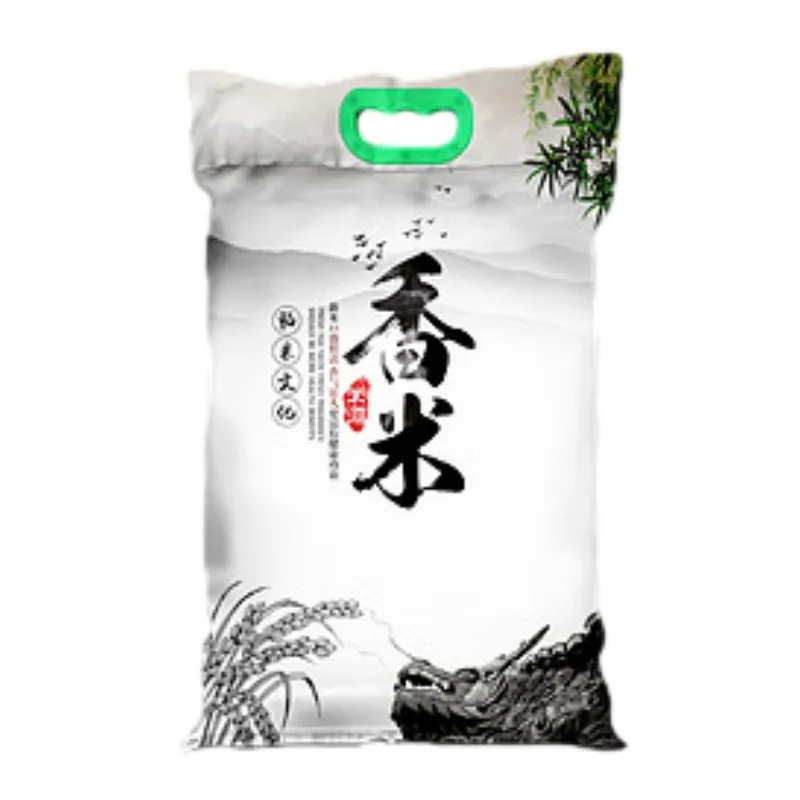
The target industries for these advanced packaging solutions primarily include agricultural producers, food processors, retail chains, and international commodity traders. Advantages in typical application scenarios include enhanced energy saving through reduced spoilage, superior moisture and oxygen resistance, and robust protection against physical damage and pest ingress, ensuring product integrity from farm to consumer.
Technical Specifications and Performance Parameters
To meet the stringent demands of the food industry, especially for a sensitive product like rice, the technical specifications of packaging materials are critical. These parameters dictate the bag's ability to protect the product, maintain its quality, and ensure food safety throughout its shelf life. Our Rice and Xiaomi Packaging Bags are engineered to excel in these areas.
Product Specification Table: Rice and Xiaomi Packaging Bag
| Parameter |
Specification (Typical) |
Significance |
| Material Composition |
BOPP/PET/LLDPE (Customizable) |
Multi-layer structure for combined barrier, strength, and sealability. Food-grade compliant. |
| Total Thickness |
80 - 180 microns (µm) |
Ensures durability, puncture resistance, and contributes to barrier properties. |
| Oxygen Transmission Rate (OTR) |
< 5 cm³/(m²·24h·atm) @ 23°C, 0% RH |
Minimizes oxidation, prevents rancidity, and maintains freshness. Tested per ASTM D3985. |
| Water Vapor Transmission Rate (WVTR) |
< 5 g/(m²·24h) @ 38°C, 90% RH |
Prevents moisture absorption/loss, inhibits mold growth, and maintains texture. Tested per ASTM F1249. |
| Tensile Strength (MD/TD) |
> 50 N/15mm / > 45 N/15mm |
Indicates the material's resistance to breaking under tension, critical for handling and transport. Tested per ASTM D882. |
| Seal Strength |
> 25 N/15mm |
Ensures hermetic sealing, preventing leaks and contamination. Critical for food safety. Tested per ASTM F88. |
| Puncture Resistance |
> 80 N (Dart Drop) |
Protects against damage from sharp objects or rough handling. Tested per ASTM D1709. |
| Printing Capability |
Up to 10 colors, Gravure/Flexographic |
High-quality visual branding and clear product information. |
| Food Contact Compliance |
FDA 21 CFR, EU 10/2011 (where applicable) |
Ensures materials are safe for direct contact with food products. |
These specifications underscore the advanced engineering behind modern rice packaging bags, designed to meet the rigorous demands of global food supply chains and regulatory bodies. The precise control over these parameters allows for optimized packaging solutions that contribute significantly to food safety, waste reduction, and consumer satisfaction.
Application Scenarios and Technical Advantages
The versatility and specialized design of modern rice packaging bags enable their application across a diverse range of scenarios, from bulk agricultural storage to premium retail displays. Each application benefits from specific technical advantages engineered into these advanced packaging solutions.
Typical Application Scenarios:
- Agricultural & Wholesale Packaging: Large woven polypropylene sacks (WPP bags) are utilized for bulk packaging of paddy rice, milled white rice, brown rice, and specialty grains for transportation and storage. Their high mechanical strength protects against breakage and contamination.
- Retail Consumer Packs: Flexible pouches (stand-up, flat bottom, side gusset) made from multi-layer laminates are popular for 1kg to 10kg packs of basmati, jasmine, organic, and general-purpose rice. These bags feature high-quality printing, re-sealable zippers, and often handles for consumer convenience.
- Export & Long-Distance Shipping: High-barrier packaging, often including PET or metallized films, is critical for rice destined for international markets. This ensures protection against varying humidity levels, temperatures, and extended transit times.
- Xiaomi and Other Small Grains: Given their smaller particle size and often higher susceptibility to moisture, specialized multi-layer bags with superior barrier properties are employed to prevent clumping and maintain integrity.
- Ready-to-Cook & Instant Rice: These products often require even more sophisticated packaging, sometimes incorporating retort-grade materials to withstand high-temperature processing.
Technical Advantages:
- Extended Shelf Life: Optimized OTR and WVTR reduce oxidation and moisture ingress, significantly extending the freshness and preventing spoilage of rice and Xiaomi. This leads to reduced food waste and greater economic efficiency.
- Pest and Contaminant Protection: Hermetic seals and robust material layers create an impenetrable barrier against insects, rodents, and environmental contaminants, ensuring hygienic product delivery.
- Enhanced Brand Visibility: High-definition printing capabilities allow for vibrant graphics and clear branding, making products stand out in competitive retail environments. This is a crucial aspect for any rice packaging bags looking to capture market share.
- Durability and Puncture Resistance: Engineered material blends provide superior tear and puncture resistance, minimizing product loss due to physical damage during handling, storage, and transportation.
- Convenience Features: Integration of re-sealable zippers, easy-pour spouts, and comfortable handles significantly enhances the user experience, leading to higher customer satisfaction and repeat purchases.
- Cost-Effectiveness: While initial investment in advanced packaging may be higher, the reduction in product spoilage, transport damage, and increased market appeal often results in a lower total cost of ownership over the product lifecycle.
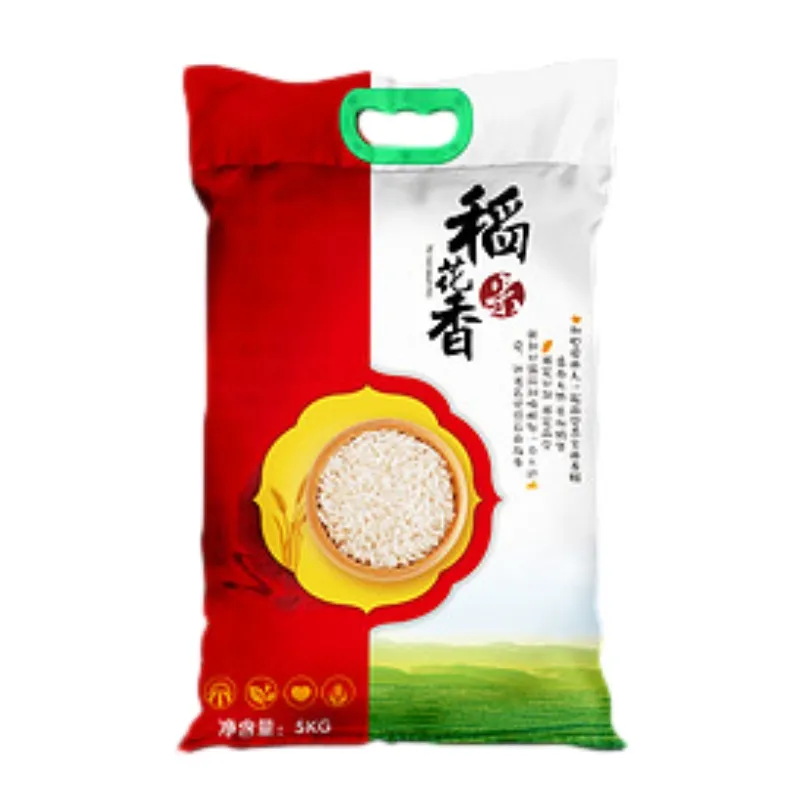
Vendor Comparison and Customized Packaging Solutions
Selecting the right packaging vendor is a strategic decision for any business in the rice and grain industry. It involves evaluating not just product quality, but also manufacturing capabilities, technical support, customization options, and adherence to international standards. Junlan Pack distinguishes itself through its comprehensive approach to delivering high-performance bags for rice packaging.
Key Vendor Comparison Criteria:
Packaging Vendor Comparison Factors
| Feature |
Industry Standard |
Junlan Pack Differentiator |
| Material Quality |
Food-grade, Basic barriers |
Premium virgin resins, advanced multi-layer films, certified food contact safe (FDA, EU). |
| Barrier Performance |
Moderate OTR/WVTR |
Optimized low OTR/WVTR for extended shelf life, customized for specific product needs. |
| Printing Quality |
Up to 8 colors, standard resolution |
High-definition gravure printing (up to 10 colors) for vivid graphics and brand fidelity. |
| Customization |
Limited sizes and features |
Full customization: size, shape, material structure, print, and integrated features (zippers, spouts, handles, windows). |
| Certifications |
Basic manufacturing standards |
ISO 9001, ISO 22000, HACCP, BRCGS, and FDA/EU compliant materials. |
| Technical Support |
Standard assistance |
Dedicated technical consultation, R&D support for new material development, after-sales service. |
Tailored Customization Solutions:
Recognizing that every brand and product has unique requirements, Junlan Pack offers extensive customization for rice packaging bags:
- Material Engineering: Developing specific laminate structures to achieve desired OTR/WVTR, puncture resistance, or recyclability goals. This could involve combining PET, BOPP, PE, EVOH, or even fully compostable options.
- Size & Format Flexibility: Producing bags in precise dimensions and styles (e.g., custom gusset depths, specific stand-up pouch configurations) to perfectly fit product volume and retail shelf space.
- Graphic Design & Printing: Collaborating with clients from concept to final print, ensuring brand aesthetics are accurately and vibrantly reproduced using advanced color management systems.
- Integrated Features: Incorporating specialized features such as laser scoring for easy tear, pour spouts, ergonomic handles, clear windows for product visibility, anti-fog properties, and various re-sealable zipper types.
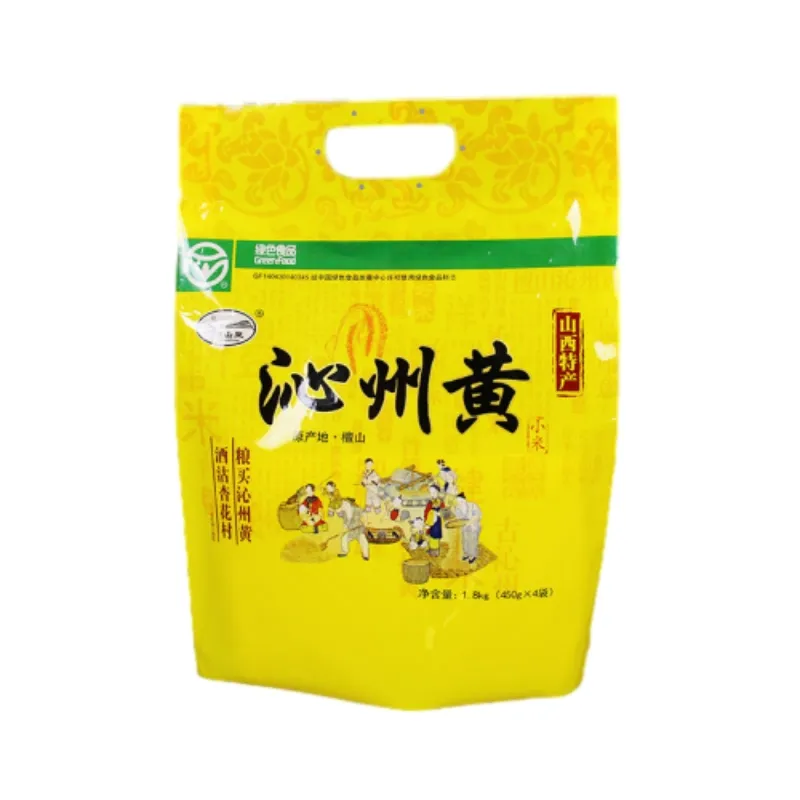
Real-World Application Case Studies and Customer Feedback
The practical impact of well-engineered rice packaging bags is best illustrated through real-world applications and the testimonials of satisfied clients. These examples demonstrate how strategic packaging choices can lead to measurable improvements in product integrity, market reach, and brand loyalty.
Case Study 1: Premium Organic Rice Brand Expansion
A rapidly growing organic rice brand sought to expand its market presence into new regions with varying climates. Their existing packaging offered insufficient moisture and oxygen barriers, leading to sporadic spoilage complaints during transit and storage in humid environments. Junlan Pack collaborated to develop a custom multi-layer stand-up pouch with an enhanced PET/AL/LLDPE structure. This solution provided superior OTR/WVTR performance, a robust re-sealable zipper, and high-definition matte finish printing to reinforce the premium organic branding.
- Outcome: The brand reported a 90% reduction in spoilage claims, enabling successful expansion into five new international markets. Sales increased by 35% in the first year post-packaging change, attributed partly to improved shelf appeal and customer confidence.
Case Study 2: Bulk Grain Distributor – Operational Efficiency
A large-scale distributor of bulk rice and grains faced challenges with bag breakage and pest infestation during warehousing and long-haul trucking using standard woven sacks. The issue led to significant product loss and repacking costs. Junlan Pack introduced a heavy-duty, reinforced Woven Polypropylene (WPP) bag with an inner PE liner, engineered for superior puncture resistance and a tighter weave. The bags were also designed with reinforced stitching and UV stabilizers for outdoor storage.
- Outcome: Bag breakage decreased by over 75%, and pest-related product damage was virtually eliminated. The distributor realized a 15% saving in operational costs related to product loss and repacking within six months.
Customer Feedback Highlights:
"The new custom packaging for our 'Golden Harvest' rice has been a game-changer. Our product now stands out on the shelves, and we've received fantastic feedback on the re-sealable feature. Junlan Pack's attention to detail and technical expertise truly made a difference."
"For years, we struggled with the durability of our large format rice packing bag for sale. Junlan Pack's engineers helped us select the ideal material and design, leading to a significant reduction in our operational losses. Their technical support was invaluable."
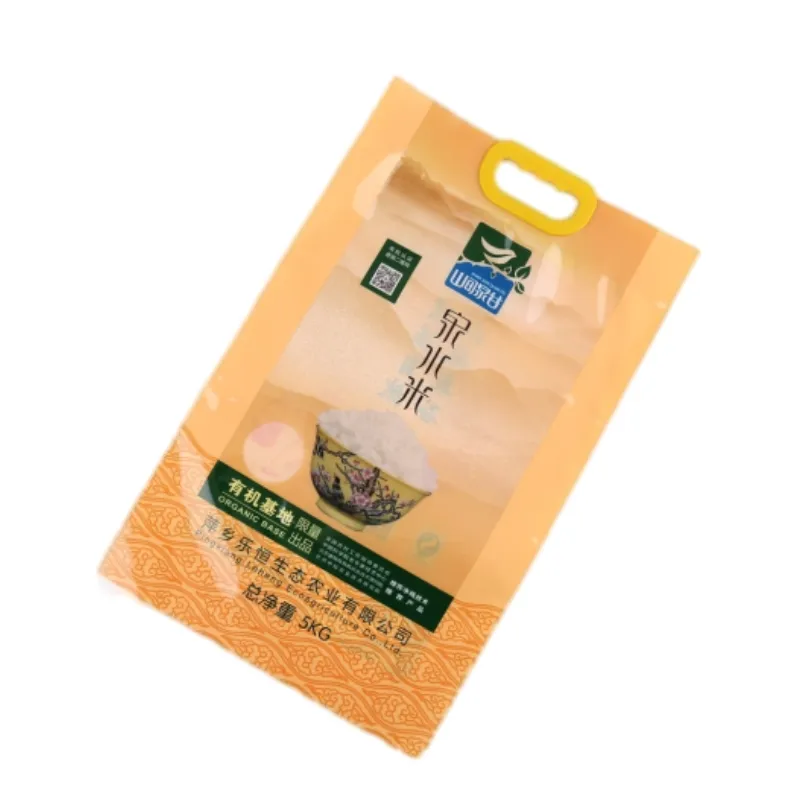
Quality Assurance, Certifications, and Compliance
Establishing and maintaining the highest standards of quality is non-negotiable in food packaging. Junlan Pack's commitment to excellence is underpinned by rigorous quality assurance protocols and adherence to globally recognized certifications. This robust framework ensures that every batch of rice packaging bags meets precise specifications for performance, safety, and regulatory compliance.
Certifications and Standards:
- ISO 9001:2015: Certified Quality Management System, demonstrating our consistent ability to provide products and services that meet customer and regulatory requirements.
- ISO 22000:2018: Food Safety Management System, ensuring that all our packaging materials are produced under strict hygienic conditions to prevent contamination.
- HACCP (Hazard Analysis and Critical Control Points): Implementation of a systematic preventative approach to food safety from biological, chemical, and physical hazards.
- BRCGS (Brand Reputation Compliance Global Standards) for Packaging Materials: A global standard that assures manufacturers are meeting their legal obligations and providing protection for the end consumer.
- FDA (Food and Drug Administration) Compliance: All food-contact materials adhere to FDA regulations (e.g., 21 CFR Parts 170-199) for safe use in packaging food products.
- EU 10/2011: Compliance with European Union regulations regarding plastic materials and articles intended to come into contact with food.
Internal Quality Control Processes:
- Raw Material Inspection: Incoming materials undergo rigorous testing for purity, consistency, and compliance before entering production.
- In-Process Monitoring: Real-time checks during printing, lamination, and bag-forming stages to ensure specifications are met (e.g., color registration, seal integrity, layer thickness).
- Finished Product Testing: Comprehensive evaluation of completed bags for parameters such as OTR, WVTR, tensile strength, burst strength, seal strength, and dimensional accuracy using calibrated equipment and international testing standards (e.g., ASTM, ISO).
- Traceability: Batch tracking systems allow for complete traceability of materials and production history, from raw material to finished product.
Our dedication to these standards underscores our role as an authoritative and trustworthy supplier in the B2B packaging sector, ensuring clients receive consistently high-quality and safe products.
Trustworthiness, Support, and Logistics
At Junlan Pack, we understand that trust is built through transparent processes, clear commitments, and reliable support. Our commitment extends beyond delivering superior bags for rice packaging; it encompasses the entire customer journey, from initial inquiry to after-sales service.
Frequently Asked Questions (FAQ):
Q1: What is your typical lead time for custom orders?
A1: Our standard lead time for custom-printed and converted packaging ranges from 15-25 business days after final artwork and material approval. This duration can vary based on order volume, material complexity, and current production schedules. We provide precise lead time estimates at the quoting stage.
Q2: Can your packaging be made from sustainable materials?
A2: Yes, we offer a growing range of sustainable options, including recyclable mono-material films (e.g., all-PE laminates), compostable films, and materials with recycled content. We work closely with clients to balance sustainability goals with performance requirements.
Q3: What are your minimum order quantity (MOQ) requirements?
A3: MOQs vary depending on the specific product type, material, and printing requirements. For flexible packaging, MOQs typically start from 5,000 to 10,000 units. Please contact our sales team for detailed information tailored to your specific needs.
Q4: How do you ensure consistency in color printing across different batches?
A4: We utilize advanced color management systems (e.g., X-Rite Spectrophotometers), maintain strict ink formulation control, and conduct in-line visual inspections to ensure consistent brand color reproduction across all print runs. Our gravure printing process is known for its high color fidelity and repeatability.
Lead Time and Fulfillment:
Junlan Pack operates with optimized production lines and a robust supply chain to ensure efficient order fulfillment. Our lead times are clearly communicated and managed from order confirmation to delivery, with real-time updates available. We leverage strategic logistics partnerships to ensure timely and cost-effective delivery of your rice packing bags globally.
Warranty and Quality Commitment:
We stand behind the quality of our products. All Rice and Xiaomi Packaging Bags are manufactured to the highest industry standards and are subject to our comprehensive quality assurance program. In the unlikely event of a manufacturing defect, Junlan Pack is committed to working with clients to promptly resolve issues, offering replacement or credit in accordance with our terms and conditions. Our warranty covers material defects and manufacturing errors for a specified period from the date of shipment.
Dedicated Customer Support:
Our team of experienced account managers and technical specialists is dedicated to providing unparalleled customer support. From initial consultation and design to post-delivery assistance, we offer:
- Technical Guidance: Expert advice on material selection, barrier properties, and structural design.
- Design Consultation: Assistance with artwork preparation and optimization for print.
- Order Tracking: Transparent communication regarding production status and shipping.
- After-Sales Service: Prompt response to any queries or issues post-delivery.
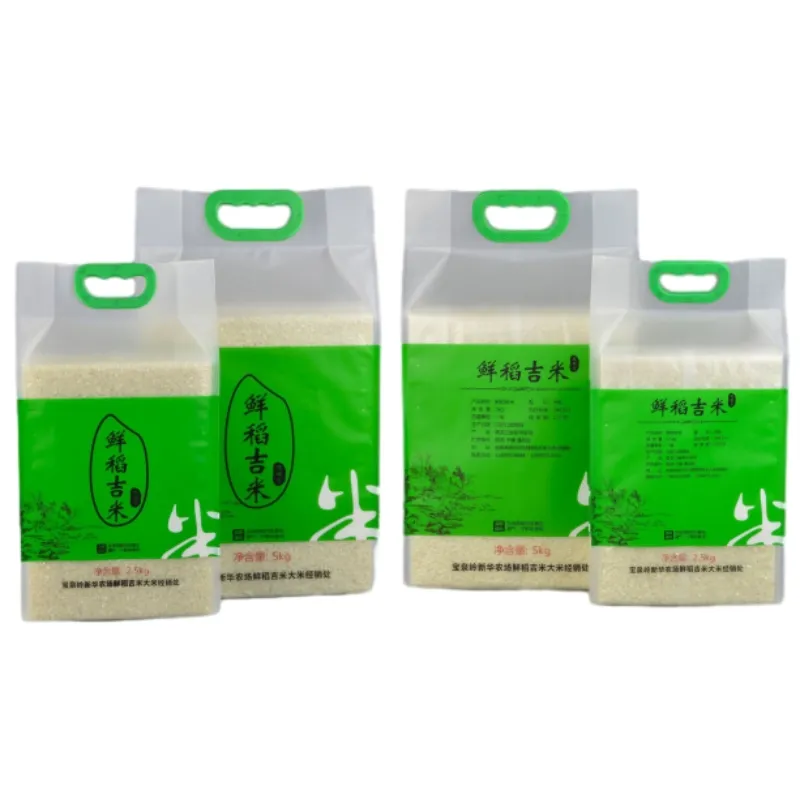
Conclusion and Future Outlook for Rice Packaging
The landscape of rice packaging is dynamic and continually evolving, driven by innovation, sustainability imperatives, and the ever-increasing demands of a global market. From basic protective functions to advanced branding tools, the diverse types of rice packaging bags are critical components of the food supply chain. Choosing the optimal packaging solution requires a deep understanding of material science, manufacturing processes, and specific application challenges.
As a professional B2B partner, Junlan Pack is dedicated to providing cutting-edge, reliable, and customized rice and Xiaomi packaging solutions that not only meet but exceed industry standards. Our commitment to quality, backed by rigorous certifications, extensive technical expertise, and a focus on customer success, ensures that our packaging contributes positively to product preservation, brand recognition, and operational efficiency.
Future Directions in Rice Packaging:
- Enhanced Sustainability: Continued development of fully recyclable, compostable, and bio-based packaging materials.
- Smart Packaging: Integration of QR codes, RFID tags, or time-temperature indicators for enhanced traceability, anti-counterfeiting, and freshness monitoring.
- Advanced Barrier Technologies: Further innovation in ultra-high barrier films and active packaging systems (e.g., oxygen scavengers) for even longer shelf life under challenging conditions.
- Consumer-Centric Design: More intuitive and convenient features, responding to diverse demographic needs and consumption patterns.
By staying at the forefront of these advancements, Junlan Pack empowers its clients to navigate market complexities and deliver their products safely and appealingly to consumers worldwide, ensuring the integrity and value of their rice and Xiaomi products.
References:
- Smith, J. (2023). "Innovations in Flexible Packaging for Dry Goods." Journal of Packaging Technology & Research, 12(3), 201-215.
- Packaging World. (2023). "The Evolution of Sustainable Food Packaging." Available at: packagingworld.com
- Food and Drug Administration (FDA). (2023). "Food Additive Status List." Available at: fda.gov
- ASTM International. (2023). "Standards for Flexible Packaging." Available at: astm.org
- Grand View Research. (2023). "Rice Packaging Market Size, Share & Trends Analysis Report." Available at: grandviewresearch.com